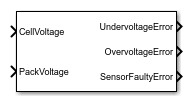Battery Voltage Monitoring
Libraries:
Simscape /
Battery /
BMS /
Protection
Description
The Battery Voltage Monitoring block monitors the voltage of a battery. Voltage protection is necessary in electrical circuits. A battery that is exposed to extremely high or extremely low voltages can enter a dangerously unstable state.
You can switch between continuous and discrete implementations of the block by using
the Sample time (-1 for inherited) parameter. To configure the
block for continuous time, set the Sample time (-1 for
inherited) parameter to 0. To configure the block for
discrete time, set the Sample time (-1 for inherited)
parameter to a positive, nonzero value, or to -1 to inherit the
sample time from an upstream block.
This diagram shows the structure of the block:

Equations
This block computes the undervoltage symptom with this equation:
This block computes the overvoltage symptom with this equation:
This block computes the faulty sensor symptom with this equation:
The check on the sum of the cell voltages assumes that all the cells are in series.
The Battery Voltage Monitoring block then passes these symptoms to a Fault Qualification block, which qualifies the errors.

